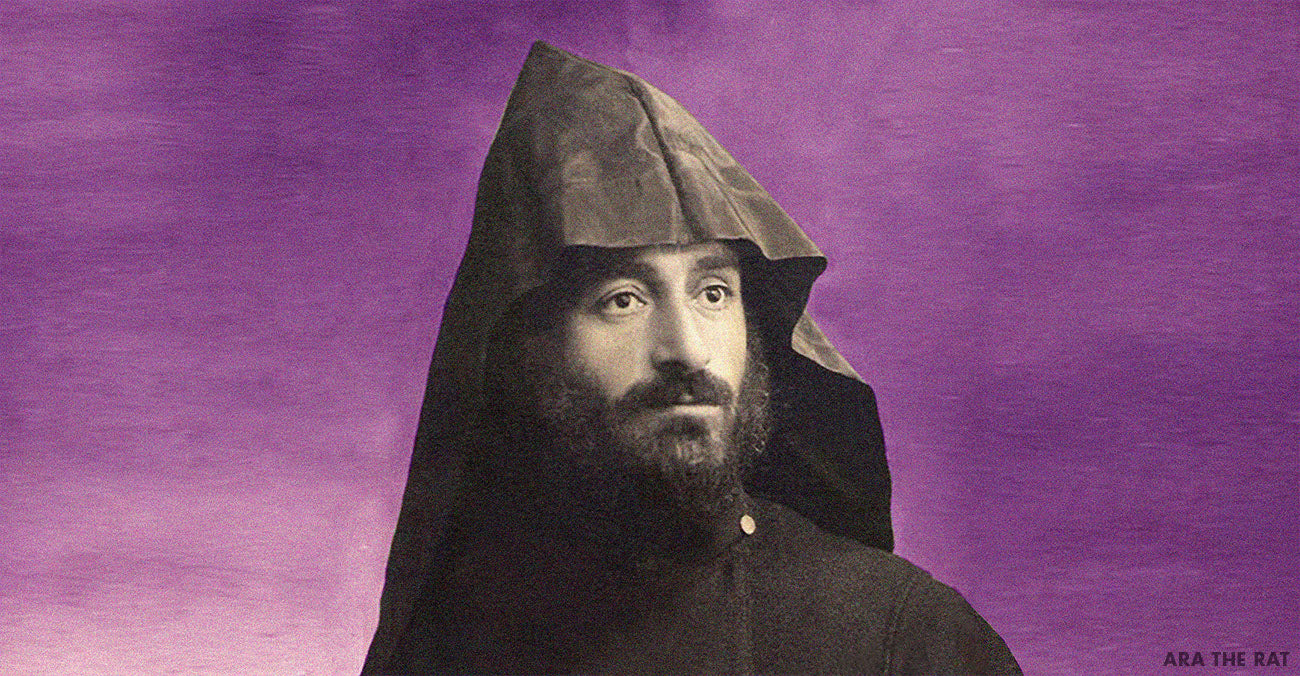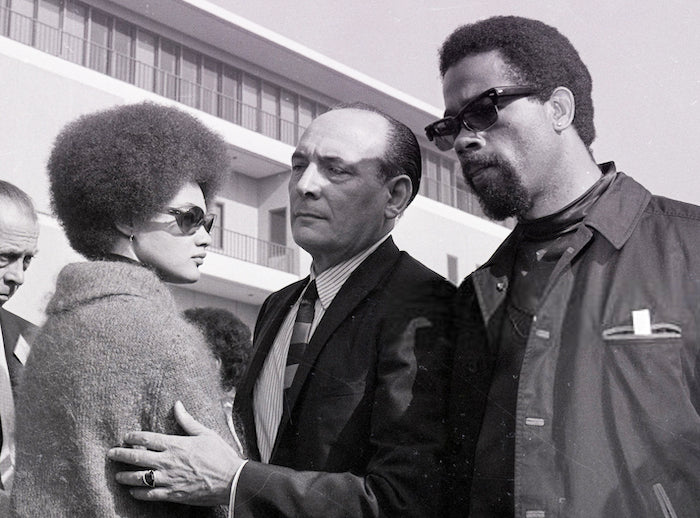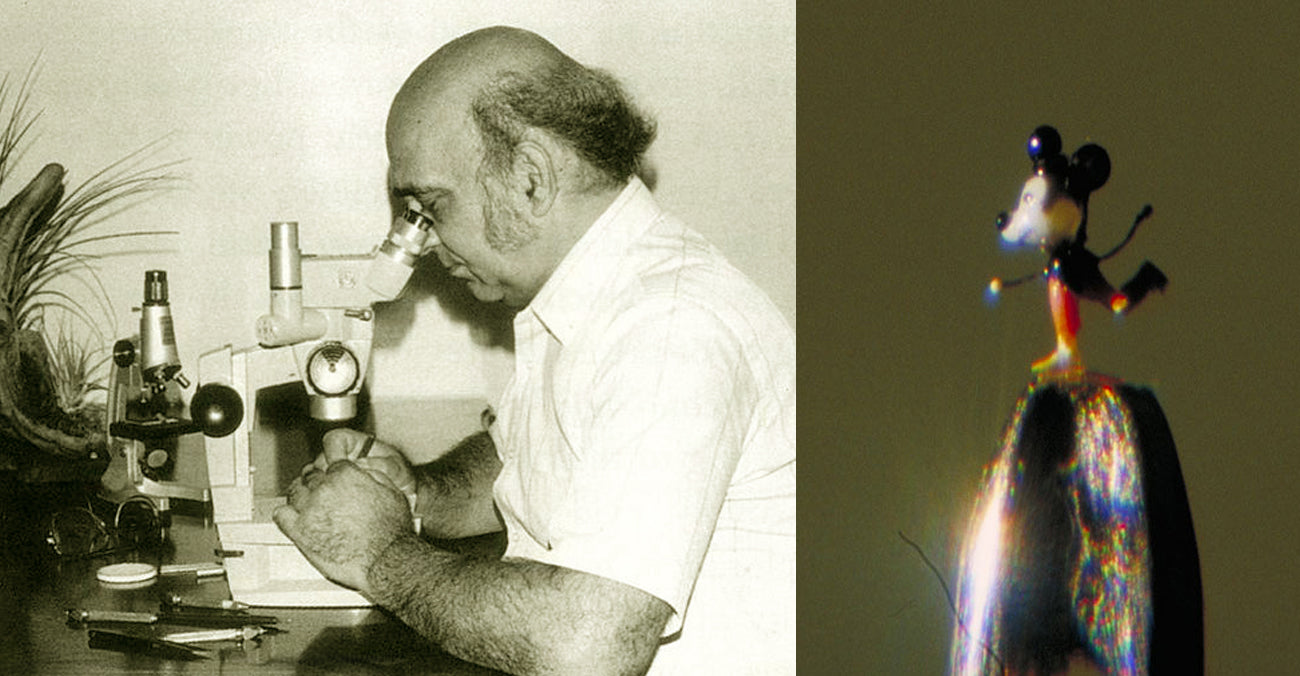
Komitas, The Future Thinker: The Unknown Story of an Armenian Icon
By Arpine Haroyan
Many people picture Komitas as a serious intellectual who was only interested in music. The musicologist, composer and singer who was also a priest, is considered the founder of the Armenian national school of music, though his efforts and accomplishments are widely unknown throughout the world.
We know about his immense contributions to Armenian music and the rich legacy he left behind, as well as his tragic end. But we rarely talk about Komitas: The Man. Who was he? And how did his life experience, including his family, brushes with the Armenian church, and friendship with singer Margarit Babayan shape him into one of the most beloved figures in Armenian history?
Komitas was not just a musical genius. He was a witty, charismatic and humorous man, a great humanitarian who became a caring teacher and remained a beloved friend.
He was born Soghomon Soghomonian in 1869 in the town of Kütahya (also known as Koutina) in the Ottoman Empire. His hometown was the center of the Ottoman Empire’s ceramics industry which was mostly produced by renowned Armenian artisans. Soghomon’s parents Takuhi and Kevork Soghomonian were also artisans; Kevork was a shoe-maker and Takuhi was a carpet-weaver. They were both gifted with beautiful voices and were well-known among Kütahya’s Armenians for their vivid musical abilities.
Unfortunately, Soghomon was not destined to experience the beautiful voice of his talented mother first hand. Several months after giving birth to Soghomon, Takuhi died.
 Kütahya, Ottoman Empire, early 1900s
Kütahya, Ottoman Empire, early 1900s
At the age of seven, Soghomon entered the elementary school of his hometown. He did not know Armenian because back in the 19th century the authorities of Kütahya had banned the use of the language in everyday life. After four years of studies, his father Kevork sent him to the city of Broosa to continue his education. However, several months after starting his studies, Kevork died and Soghomon had to come back to Kütahya.
Life was not easy for the orphaned boy. Poorly dressed Soghomon had to sleep on the cold stones in the streets and wander in the city looking for food to eat. Despite losing his parents, it turned out that he had inherited their gift afterall. Soon he became famous among Kütahya Armenians for his exceptional voice. In 1881, priest Gevorg Vardapet Derdzakyan was asked by Catholicos Gevorg IV to take a gifted orphaned boy to Etchmiadzin to study at the Gevorgian Seminary. Derdzakyan chose Soghomon.
The Catholicos was stunned by Soghomon's singing abilities and decided to accept him to the Seminary. On his end, Soghomon promised to quickly learn Armenian and officially entered the Gevorgian Seminary.
Throughout his studies, Soghomon learned the basics of Armenian music. At the beginning of the 1890s, he was appointed as the conductor of the Etchmiadzin Cathedral’s choir, as well as a music teacher at the Seminary. He was already a hieromonk and was given the name Komitas after Armenia’s 7th-century poet and priest. Five years later, he was ordained a Vardapet (а celibate priest).

Young Soghomon Soghomonian, Etchmiadzin, 1890.
During his studies at the Seminary, Komitas fell in love with Armenian folk music. His soul belonged to his nation and its music; he would visit villages near Etchmiadzin, listen to peasants’ songs, and collect them.
In 1895, he published the first collection of transcribed folk music which included love songs, lullabies, dances, and wedding songs. However, his activities ruffled feathers. Some of the church representatives at Etchmiadzin did not like his activities; they thought that Komitas’s research was not very valuable. They even started to call Komitas the “love-singing priest.”
But Komitas did not despair. His desire to discover and research Armenian music was so strong that he spared no effort in continuing his education. He moved to Tbilisi to study the principles of European music and harmony under the guidance of famous Armenian composer Makar Yekmalyan. A year later, under the leadership of Catholicos Khrimyan Hayrik and financial support of Armenian oil tycoon Alexander Mantashev, Komitas moved to Germany to continue his education.
 Komitas in Berlin, 1896.
Komitas in Berlin, 1896.
The years spent in Berlin had a great impact on his professional development. By this time, the research of folk music was largely promoted by German musicologists. Komitas soon entered the class of renowned German musicologist Richard Schmidt. He acquired knowledge about folk music and European music and soon returned to Etchmiadzin.
Throughout his career however, he faced numerous challenges because of the conservative views and beliefs of the representatives of the Armenian Apostolic Church.
"a celibate priest was not supposed to transcribe, sing or research “love” songs; it was shameful for the church."
In 1899, upon his return, Komitas put all his efforts into changing the education system and musical life in Etchmiadzin. He also continued visiting villages, communicating with peasants and transcribing folk songs. Soon, some church representatives started to question his activities, claiming that his work was not valuable. They disapproved of his behavior as a celibate priest, emphasizing that he should devote himself to the church and not to the outside world. According to some of them, a celibate priest was not supposed to transcribe, sing or research “love” songs; it was shameful for the church.
In various letters to his friends and colleagues, he sometimes complained about the church’s attitude. As tensions grew between him and some clergy, he wrote to the Catholicos asking him to set him free from the church obligations. However, he never replied.

Komitas taking a bath, Etchmiadzin, 1901
Despite the toxic attitude of the church, Komitas continued his extensive work. In the 1910s, after moving to Constantinople, he hoped that his work would be received well. However, once again, some of the church representatives unreasonably criticized his work.
The Armenian church representatives in Constantinople immediately accused Komitas of desecrating Armenian church music.
A French recording company released a record of some Armenian spiritual chants performed by singer Armenak Shahmuradyan and accompanied by Komitas. The Armenian church representatives in Constantinople immediately accused Komitas of desecrating Armenian church music noting that it shall not be distributed through records nor be available for purchase. However, several Armenian intellectuals extensively supported him, and soon the church stepped back.
"Hov areq sarer" ("Make breeze, dear mountains") Original live recording by Komitas
During this period he also undertook major research on the Armenian khazes (a special Armenian “neume” or notational system in music for which the key was yet to be discovered) and extensively traveled across Europe. He published articles in European academic magazines, lectured about Armenian music, and largely promoted it.

Komitas in his apartment, Constantinople, 1913
But for those close to him, he was a man who encompassed more than just music. Komitas was a beloved colleague and friend to many Armenian intellectuals of the times.

Celebrated Armenian writer Hovhannes Tumanyan was one of them. Once in a letter to Tumanyan, Komitas joked about why he wasn’t coming to see him:
“Dear Hovhannes. You didn’t come to Etchmiadzin. Perhaps the mosquitoes frightened you. Who the mosquito is to frighten a man? I could have offered you such a place to stay that no mosquito, not even the mosquito’s brother and its offspring could enter.”
Mosquitos were his “greatest” enemies, as noted Armenian linguist Hrachia Ajarian recalled, so much so that he decided to dedicate a poem to the insect that would not let him work, sending it to his beloved friend Margarit Babayan. Komitas’s close friendship with Babyan, a renowned mezzo-soprano and vocal teacher, is largely unexplored.

Margarit Babayan, photo with her signature.
Komitas was a celibate priest and the fact that he might have been in love with Margarit Babayan was controversial. As such, their story was ignored in many of his biographies.
Komitas and Margarit first met in 1895. In 1902, he gave a small concert in Tbilisi, Georgia. His extraordinary performance touched Margarit and led to their long-lasting friendship.
In the beginning, Komitas and Margarit’s relationship was quite professional. They would work together on the promotion of Armenian music and publication of books about Armenian folk songs.
In 1904 Margarit moved to Paris, though she remained in touch with him. As time passed and their friendship grew, their letters became more personal and informal. Komitas started to draw sketches in his letters to Margarit and call her “darling.” He told Margarit about his worries; he complained about the Church, shared with her his dreams and plans. Komitas and Margarit’s letters reveal how close they were and how important their relationship was for both of them.

"And this is me" - a sketch by Komitas in a letter to Margarit Babayan
In 1906, Komitas traveled to Europe and settled in Paris for several months. It was a great opportunity for them to see each other more frequently, attend concerts together, and promote Armenian music. During this time, Margarit and Komitas founded a choir together and gave a big concert of Armenian music.
After Komitas left Paris, he did not see Margarit for several years. However, the distance was not a barrier for them; they would send each other numerous letters, photographs and postcards. During this time Komitas was busy traveling and lecturing, and Margarit dedicated herself to teaching.
In 1911, Komitas surprised Margarit and visited her again. Together, they traveled to the Isle of Wight, an island off the coast of England, and spent several weeks there by the sea. Later in her memoir, Margarit recalled their vacation with great excitement, confessing that after their trip she was “fascinated by him even more.” According to her, during their holiday in the Isle of Wight, Komitas would work on new Armenian songs and they would have beautiful discussions about culture and music all the time.
 Isle of Wight, early 1900s
Isle of Wight, early 1900s
After the vacation in the Isle of Wight, Margarit and Komitas met again three years later, in 1914. It was probably the last time they saw each other. The last preserved letter from Komitas also dates back to 1914.
In the letters to his friends, he sometimes confessed that people do not understand the importance of his work hence they are not willing to support him financially.
Though their true feelings for each other remain a mystery, Margarit was a presence in Komitas’s life until the end. While he remained in a psychiatric hospital in Paris in his later years, Margarit greatly contributed to the Komitas Caretaker Committee of Paris, and later to the collection of Komitas’s archive. However, Margarit did not write about the last years of his life. As she had once mentioned, “Komitas was already in a different world.”
 "The Future Thinker" a sketch by Komitas in a letter to Margarit Babayan
"The Future Thinker" a sketch by Komitas in a letter to Margarit Babayan
The tragic events of the Armenian Genocide that led to Komitas ending up in a psychiatric hospital are well known, but the details of his life before it was irreparably damaged remain less explored.
Even though he did tremendous work on Armenian music, Komitas did not have steady financial support. In the letters to his friends, he sometimes confessed that people do not understand the importance of his work hence they are not willing to support him financially. However, he was never held back because of financial difficulties and always helped those in need.
One day in 1901, singer Shara Talyan was waiting for Komitas so that they could have breakfast together. Hours passed and he did not show up. Finally, arriving late, Komitas told Talyan that he found a wallet on the street and decided to look for the owner. After waiting for 4 hours, a desperate girl came to that area and he realized that the wallet belonged to her. As Talyan explained, Komitas thought that the wallet belonged to a worker and the money inside would be much needed by the owner so he decided to wait as long as he could.
In 1910, Komitas left Etchmiadzin for Constantinople hoping that he would find better conditions to continue his work. Here he established a choir named “Gusan” which gave concerts in different countries.

Komitas's "Gusan" Choir, Constantinople, 1910
By this time, Komitas was a well respected and notable musician; he was working on the opera “Anush” based on the poem of Armenian famous writer Hovhannes Tumanyan, exploring Armenian and Kurdish folk music, and had almost cracked the code of Armenian "neume" notation system. However, one tragic night, Komitas’s life turned upside down, putting an end to the prolific career of the father of Armenian music.
It was April of 1915. The Ottoman authorities, who had already started the massacres of Armenians, arrested and exiled hundreds of Armenian intellectuals including Komitas. He spent several months in exile and witnessed the dreadful treatment of the Ottoman authorities. However, thanks to the interventions of the U.S. Ambassador in the Ottoman Empire Henry Morgenthau, and Komitas’s influential Turkish friends, the Ottoman authorities soon freed him and sent him to Constantinople.
Unfortunately, upon his return, Komitas was already suffering a mental breakdown.
When he saw that the state authorities had taken his documents, which included more than 1,000 song transcriptions and research papers revealing the Armenian notation system, his emotional state became even worse. His friends soon placed him in a hospital in Constantinople and several months later he was transferred to a psychiatric hospital in Paris. There was no hope that he would recover.
For many years, it was assumed that he suffered schizophrenia.
During his stay in the psychiatric clinic, many of his friends visited him and tried to communicate. Most of the time, Komitas refused to see them. As some of them recalled, he was always gloomy and sad, as if he was mourning the victims of the Armenian Genocide.
In 1935, after spending 19 years in a psychiatric clinic, Komitas died. In the 1980s, after revealing the documents about Komitas’s condition in the psychiatric clinic in Villejuif (a suburb in Paris), researchers discovered that his death was caused by an infection in his foot. For many years, it was assumed that he suffered schizophrenia. However, some of the researchers suggest that Komitas never had an incurable mental disease: instead, he was disappointed by humanity and preferred to not talk.
In 1936, his remains were transferred to Yerevan and buried in the Pantheon named after him. He remains one of the most celebrated and influential figures for Armenians worldwide. In 2015, on the centennial of the Armenian Genocide, the Komitas Museum-Institute, a biographical museum devoted to him and his work was opened. In 2019, his 150th birth anniversary and contributions to Armenian music was recognized by UNESCO.

"Chinar Es" ("Tall as a Poplar Tree") by Komitas - Performed by the Armenian Philharmonic Orchestra
~
Arpine Haroyan is a journalist and a podcast producer at EVN Report. She has studied musicology at the Yerevan State Conservatory and graduated from the American University of Armenia with a degree in communications. She is passionate about archival stories, culture and has a special article series at EVN Report entitled "From the Forgotten Pages of History" featuring unique lives of Armenian women.
© Ara the Rat, 2020. Unauthorized use and/or duplication of this original material without express and written permission from this site’s owner is strictly prohibited.



132 comments
музыка мп3
Elmerzox
группы песнь
Weldoninput
текст песни
LanceIdefs
mp3 скачать качество бесплатно
SteveCheme
Muchas gracias. ?Como puedo iniciar sesion?
iuxkjykaoi
mp3 в хорошем качестве
MichaelCat
бесплатная популярная музыка 20201
Martinenete
песнь популярные
WilliamBenny
дали дали песня
Jamescew
моргенштерн песни
MelvinHob
русская песнь
Williamunove
бела бела песня
DuaneDielM
скачать песню ремикс
Josephbab
скачать хорошие песни mp3
Barrywaw
mp3 2021
IsmaelIdode
данные песни
Joshuawoope
песня про
Brianedurl
скачать песни бесплатно
Horaceneuff
новинки музыки бесплатно
Edwardgremy
песни онлайн слушать бесплатно
RichardWemem
скачать песню
Jamessib
песни черных
Ronaldbiowl
качество песни
HaroldSlumS
музыка онлайн без
KennethZew
бесплатно mp3 все песни в хорошем песни
Williamgaf
музыка 2021 без
Angelofaw
русская музыка бесплатно
Charleshypor
песня любящая
MichaelSorie
mp3
Thomasallex
песня руки
KennethHailT
музыка
Josephlaurb
музыка играна
GregoryTaize
песни 2021 бесплатно
JustinPah
бела бела песня
GreggSizic
скачать песни бесплатно в качестве mp3
DarrellGreno
песня
DavidTooff
слушать песни в хорошем качестве
RaymondSit
слушать песни
CharlesSteft
с днем рождения дне песня
WilliamWousy
новинки музыки 2021 бесплатно
Michaelstacy
детские песни
RobinGub
песни 2021 бесплатно
ThomasNof
скачать песнь 2021
Stantonadamp
найти песню
RogerCen
песня рождения
Richardmutty
купить роликовые коньки
Jeffreybum
нова песня
ThomasNeobe
песни лета 2021
Normanabift
песня с днем рождения
JohnnyVex
минус песни
MartinMog
Leave a comment
This site is protected by hCaptcha and the hCaptcha Privacy Policy and Terms of Service apply.